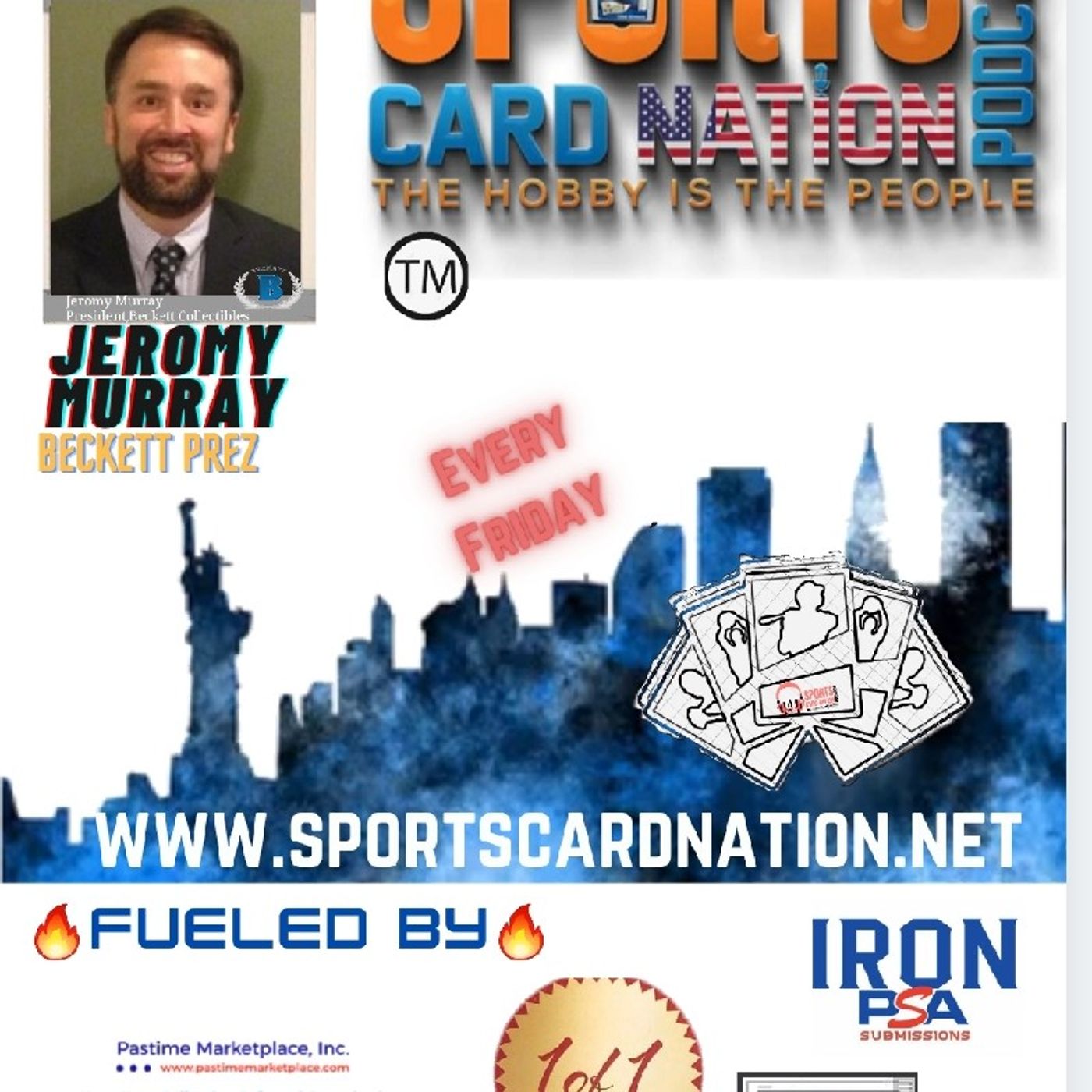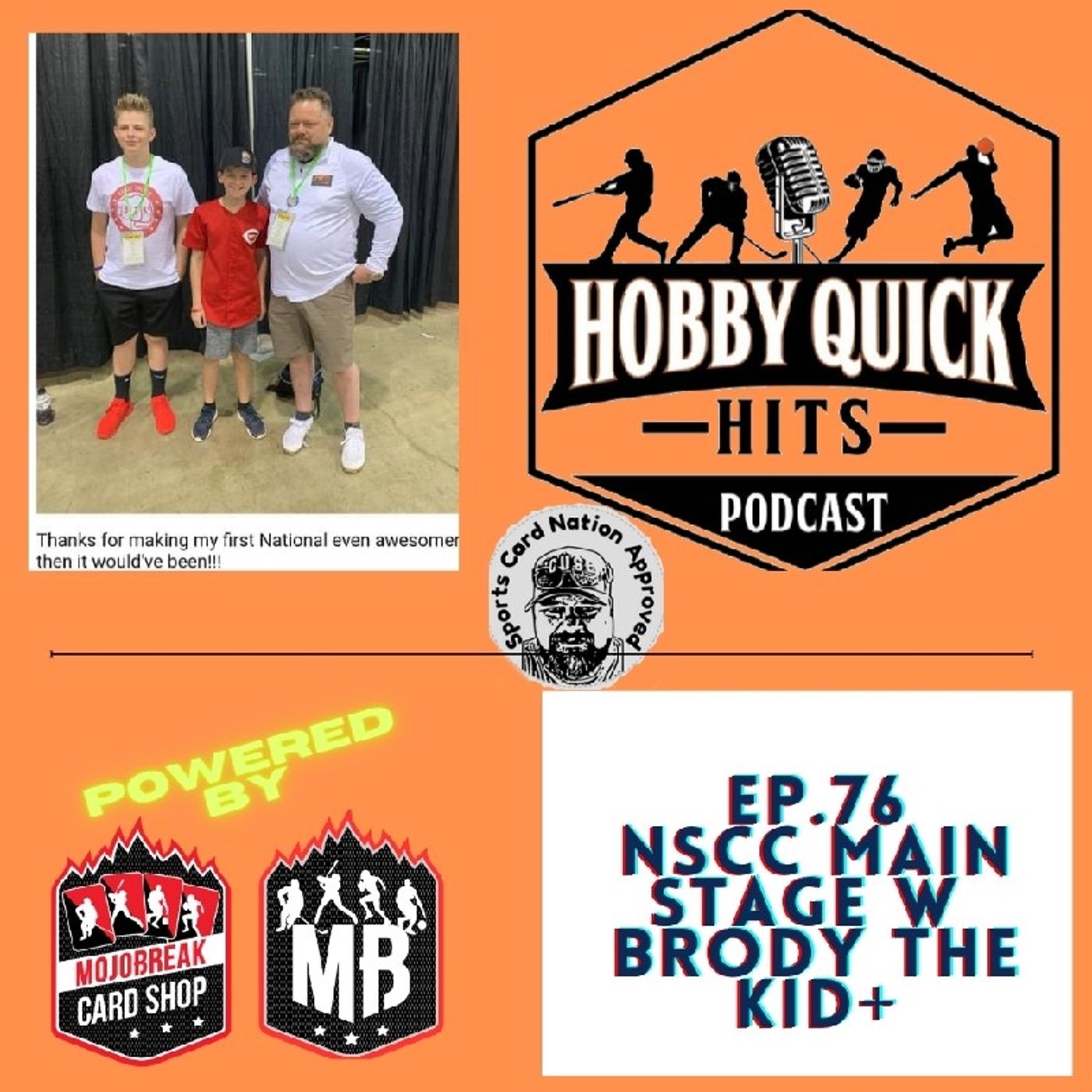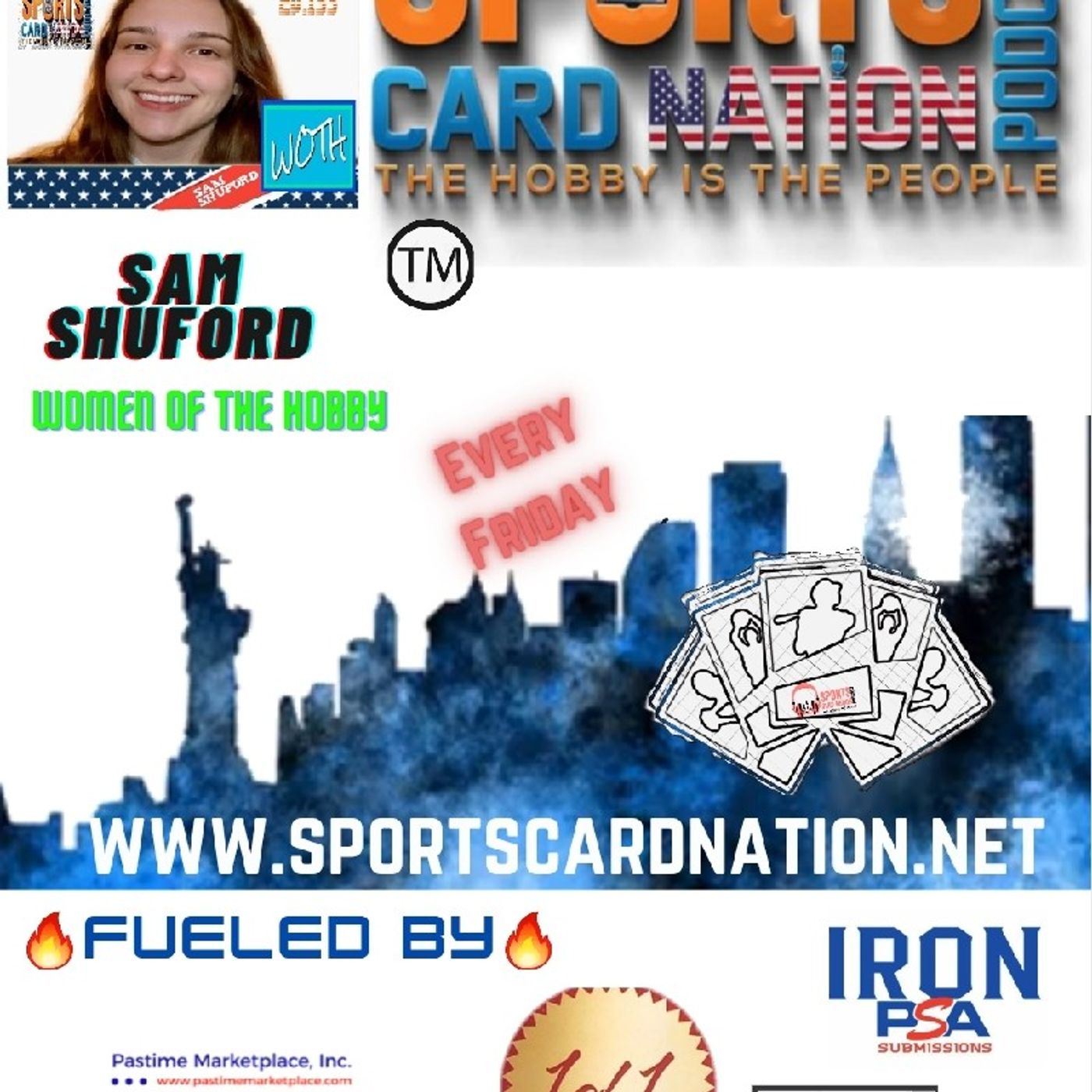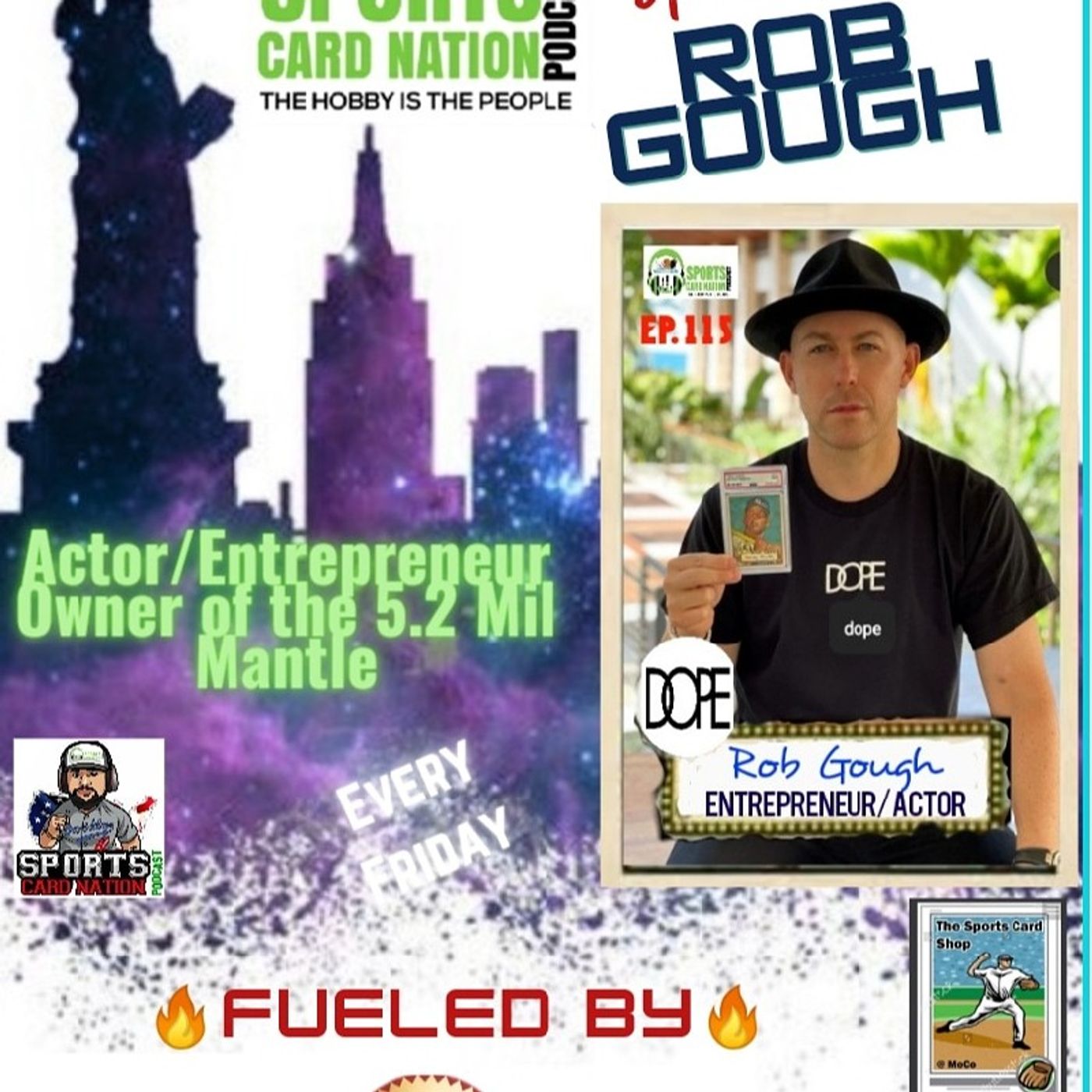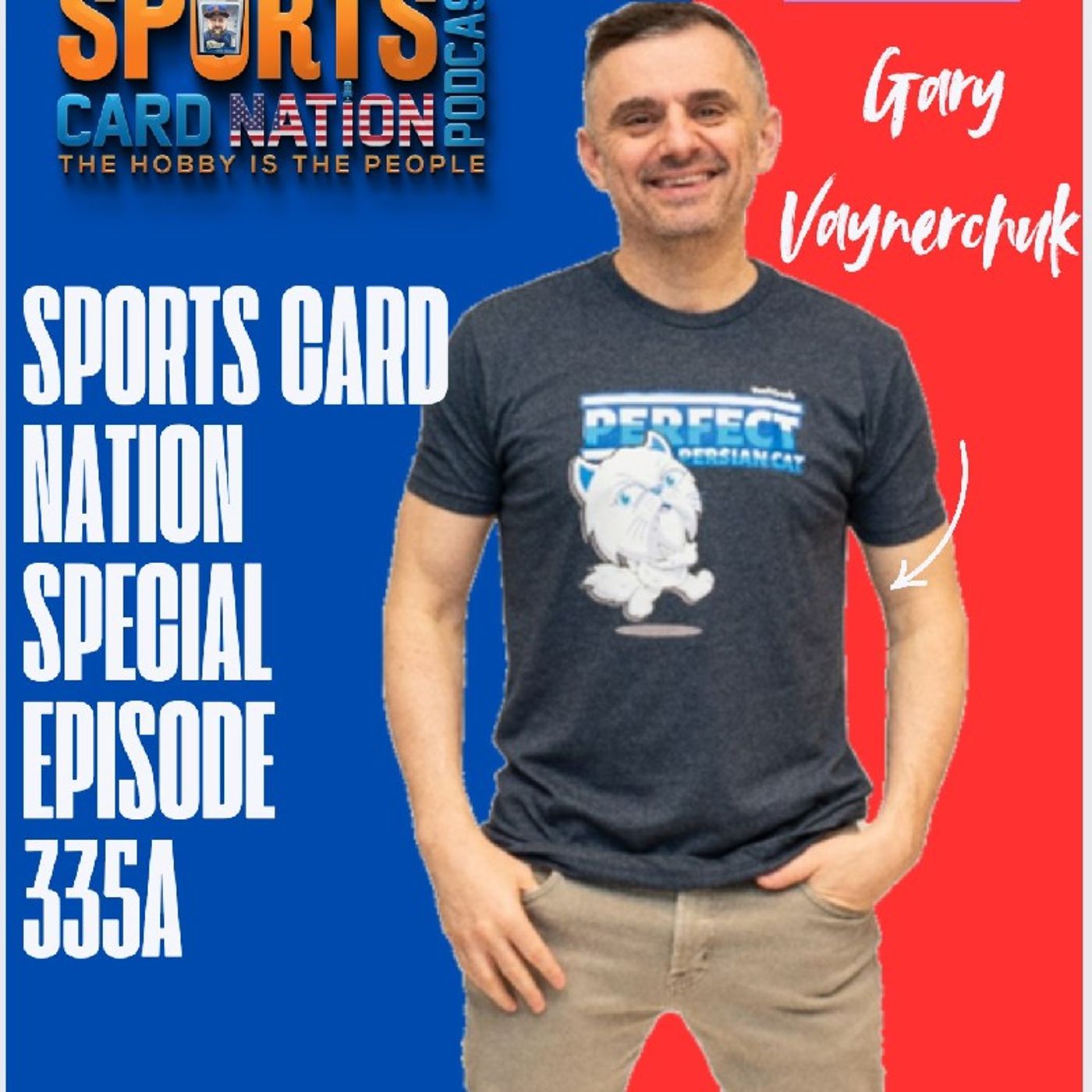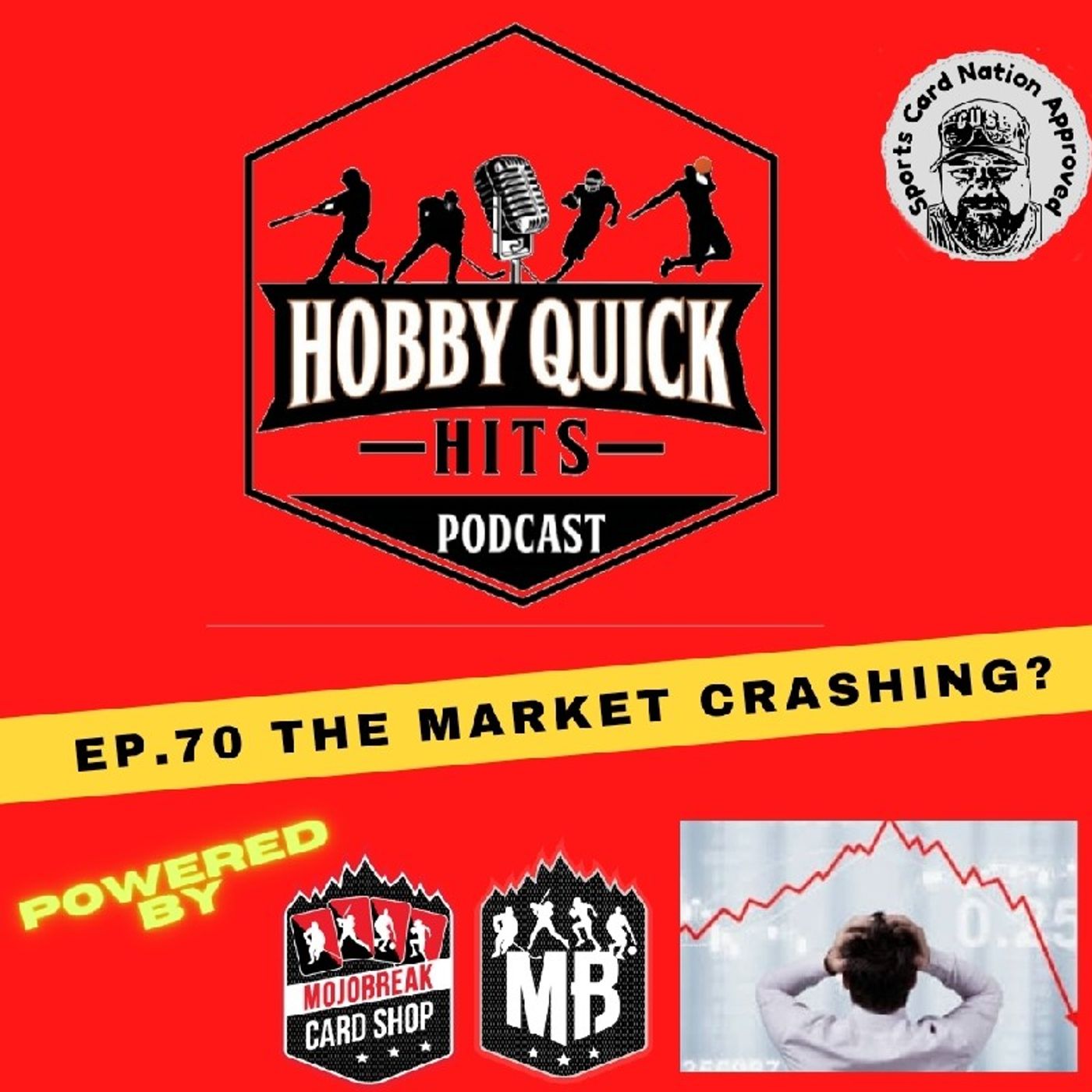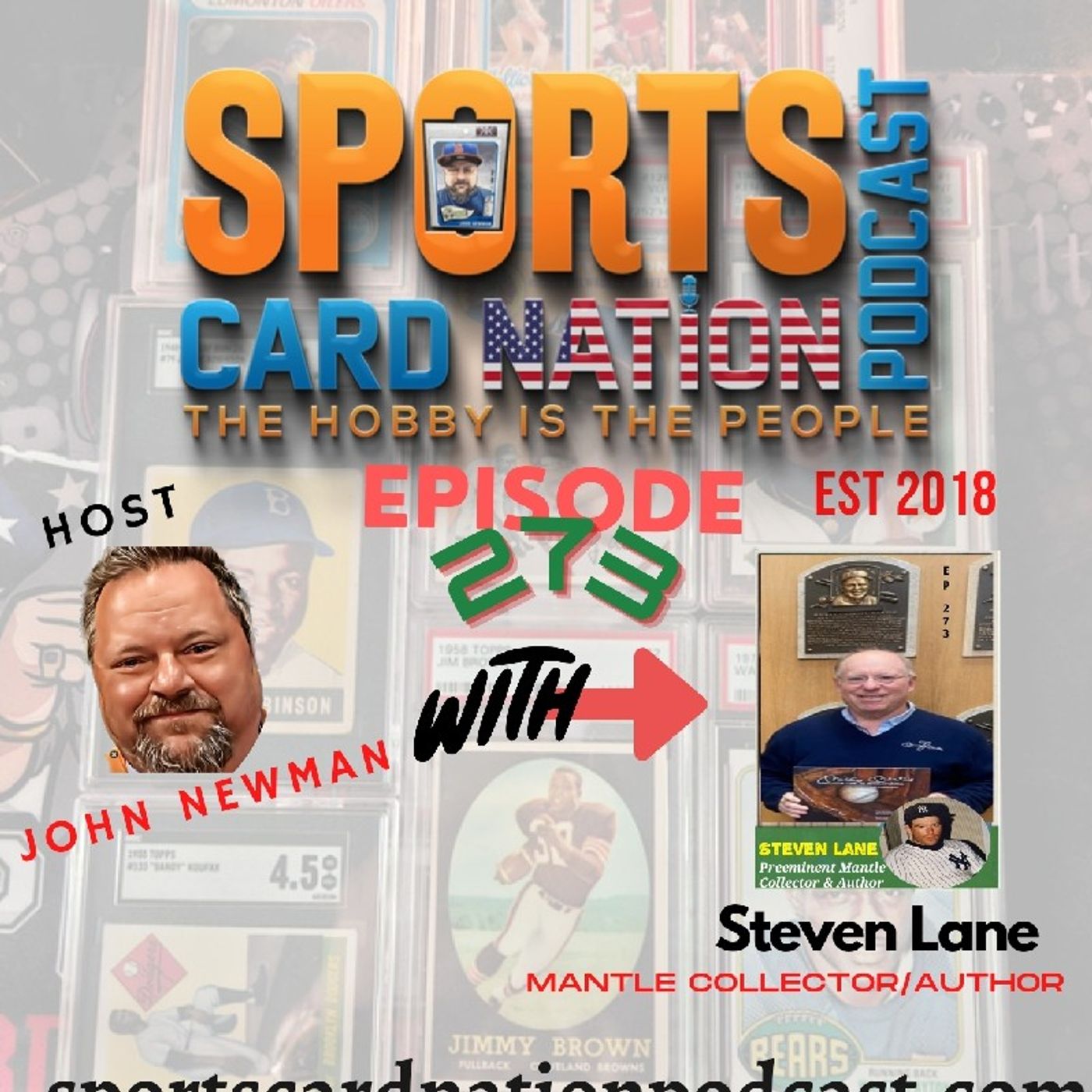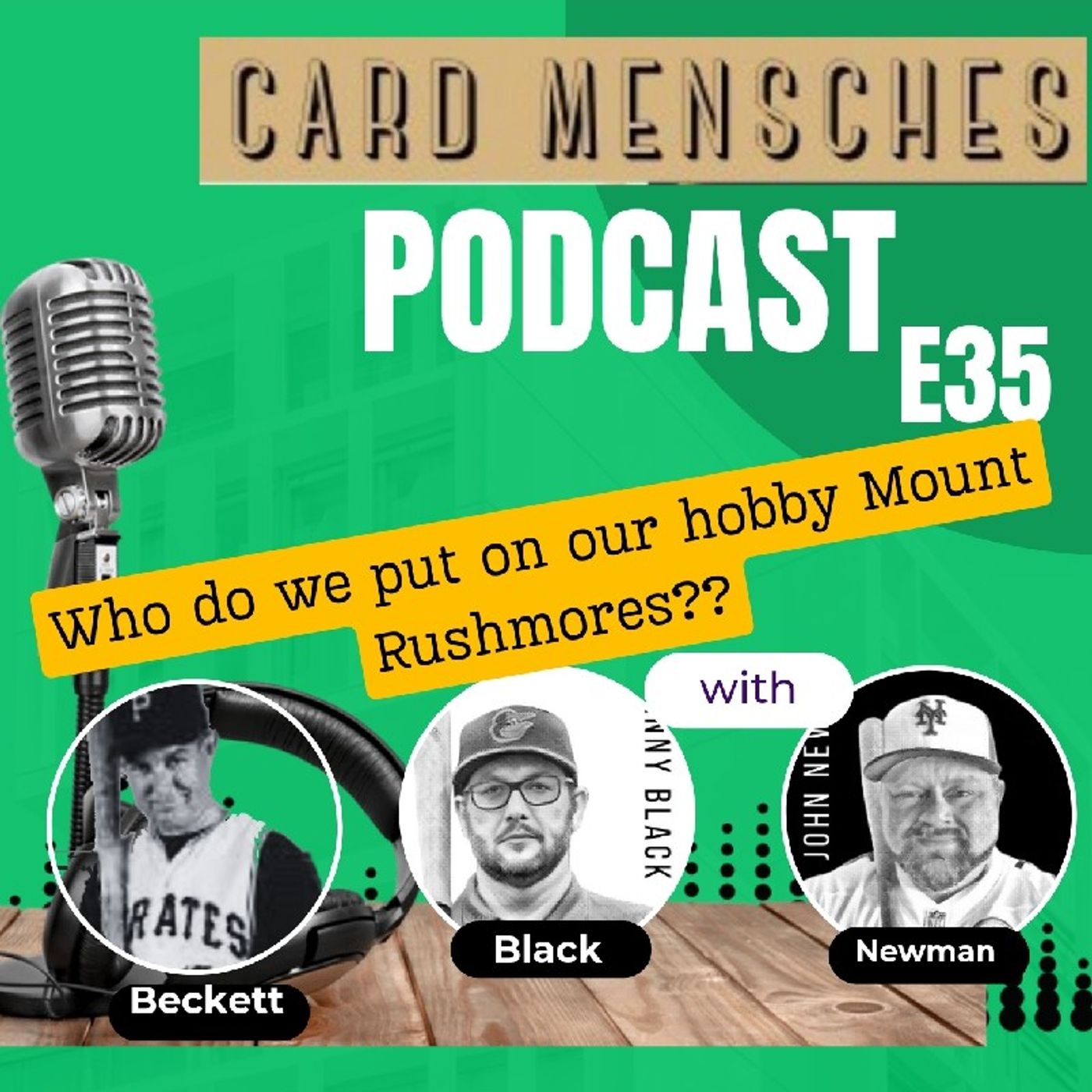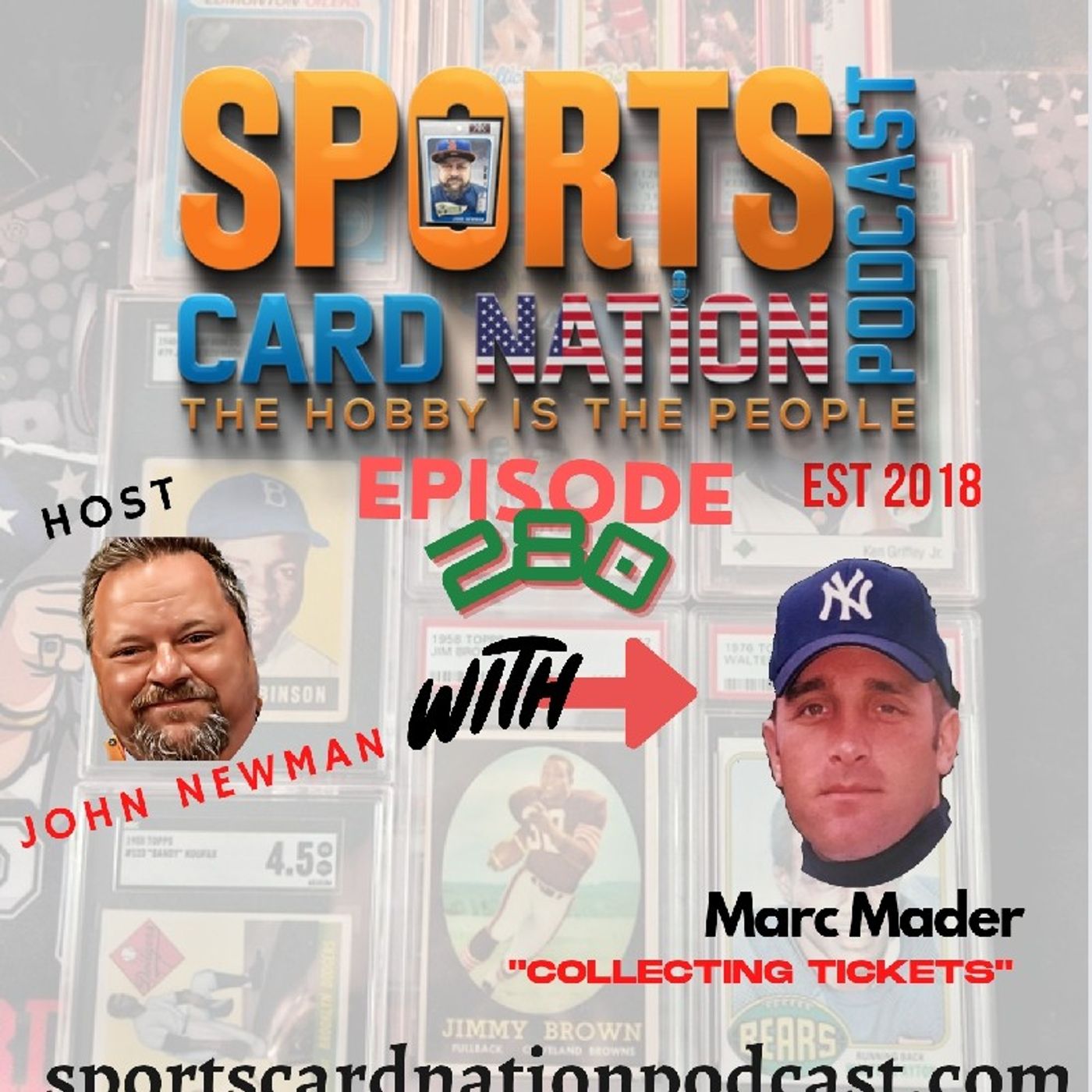Karvin Cheung "The Architect" shares hobby stories E337
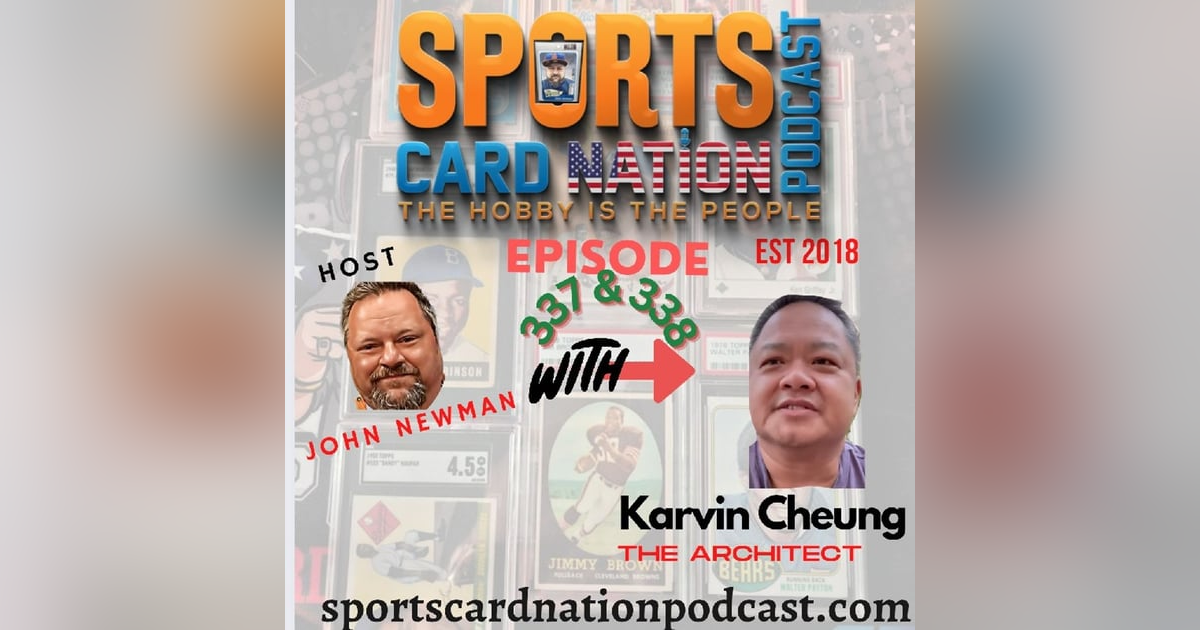
Karvin Cheung's influence on the hobby is probably more than you realize. He's a risk taker who decisions have had positive effects. He joins us today on this episode.
Talking points on this episode may include:
*The Evolution of the Hobby
*Wearing different hobby hats
*Working for Upper Deck, Working for Panini
*The Legend of the Exquisite brand
*Grail item
*Would you like to see multiple licensing again?
*Taking Risks
*NSCC Discussion
Follow us on Social Media:
Website:
https://www.sportscardnationpo...
.com
https://linktr.ee/Sportscardna...
Merch shop:
https://sports-card-nation.pri...
To eliminate pre & post-roll ads
https://www.spreaker.com/podca...
Sports guard Nations hobby is the people Wheely news and interviews. It's your number one soul. Sports Guarnations hobby is the people sports Guarnation. What is up? Everybody? Welcome to episode three point thirty seven of Sportscardination.
Have a great guest on the show today. Guy kind of wanted to talk to for a while. It's my fault we didn't get him on sooner. I talked to him at the National said love them, come on, and then I kind of was gonna interview him there and drag my feet and all on me.
But as a saying, a cliche goes right, better late than never. So he's on today's show and very important person to the hobby, especially if you're a fan of what Upper Deck has done and kind of what we're still seeing today. Right he's effectually known as the architect. I'm talking about Carbon Chung and he's you know, his big baby was exquisite, that brand, you know, and we're gonna obviously talk about that, but he's done a lot of other things too, and sometimes I think that gets overshadowed.
So we're gonna talk about kind of everything he's done. Chop up a little hobby in the process as well. So without further ado, we're going to take a quick break and then we'll be back to talk with Carbon Chung. For nearly fifty years, Sports Collectors Digest has been the voice of the hobby, bringing you comprehensive coverage of the sports collectible industry from industry news, auction results, market analysis, and in depth stories about collectors and their collections.
Sports Collectors Digest has everything you need to know about the hobby. SCD is also your leading source for listings of sports collectible dealers, card shops, card shows, and the latest from the industry's top companies. To check out all the latest news or to subscribe to the hobby's oldest magazine, visit Sports Collectorsdigest dot com or call one eight hundred eight two nine fifty five sixty one. I am genuinely excited to talk to the next gentlemen that's gracing Sports Carnation podcast.
I've apologized to them before we start recording. Should have had them on sooner, but better late than never. Mister Carbon Schung aka the Architect, welcome. Oh, thank you very much.
That was a nice intro. I love your action intro. There are almost like a news channel. So that's interesting, brings me back in the nineties.
Speaking of nineties, something we're both familiar with with hobby wise and even before and and that's kind of where I want to start off here. Carbon and I know we talked before recording. You know, we have a similar trajectory at least to start out with both veterans of setting up at the flea market and from the flea market days, opening h an LCS and and then on the bigger and better things, especially in your case when you look back upon those times, you know, the flea market days and then eventually being an LCS owner, like kind of your your thoughts on that time in your life. Well, the one thing is that for sure, it's a long journey, right and I just feel that, man, I could there's so much I could change that would have made my journey even more smoother or perhaps more successful, or you know, maybe just another career.
But you think about it and you're like, you know what, I wouldn't change anything, you know, at the end of the day. When I was a little boy, and you know, my dad used to smoke a lot and he would go to the local convenience stores and bring back two packs of hockey cards. And I was like, that almost gave him a pass, my pass for him smoking, because he's given me hockey cards. And then I started buying packs of cards, whether it's Hockey Star Wars, everything, just to have that pack opening experience.
And and the funny thing is that I don't even chew the gum. My parents never liked me chewing gum. And that that gum tasted awful back then, I'm sure it tastes even more awful when you get an house. It just it just dissolves, and that who knows what, probably.
But even back then, the flavor's gone within like five minutes. You got to get another You gotta buy another pack or have a whole stack of gum like a gobstopper in your mouth. And you know, and I know we're aging ourselves by Saint gob stoppers or some one of that, or jaw breakers. But I wouldn't change anything.
I was a big fan of the hobby. I opened a lot of products back then. I opened a lot of products when I was to have my flea market, selling singles, wax everything. In fact, some of my customers like Jason Spezza was one of my customers.
If anyone who knows Jason Spetza who's now yeah, yeah, and his dad used to love hockey cards. And then opening my first door that was great, and then working for a distributor, and you know, during this whole time when I had a card start, I was like, what if the card companies did this? And what other card companies did that? And came that opportunity when you know, Upper Decks said hey, you know, we have a position. And Upper Deck was the one company that brought me back into the trading cards. I used to love trading cards when I was like eight years old, all the way till about twelve.
Then it was almost like shame culture. I got shamed for collecting hockey cards. I go to school being my hockey cards and like are you a baby? Why are you collecting hockey cards? Why don't you just play hockey instead of collecting hockey cards? And it's almost like, Okay, well, I guess I'm not collecting anymore. I got into comic books after that and DJing vinyl, but however, I always had a fun this for hockey cards.
And later on, you know when Upper Deck came out with the double sided photos, the hologram, everything about that car just looked beautiful, and I was just said, man, I love hockey. I mean I love baseball cards now with the eighty nine upper deck set. And then that's when I got into my flea market because I managed to walk into a Sam's Club or a Walmart ended up buying like twenty boxes. I said, no, I almost set up to the flea market and that started the whole trend of that journey.
But then with that being said, I. Was I had a successful store and everything, and I was like, but what if you could do something to change cards? Make it what I want to be, you know, selfishly, I want to create cards for myself. And I was like, there came the opportunity. However, it came with a big pay pay reduction for me.
It was close to seventy percent pay cut with what I was doing on my own and had my day job, and I was just like, man is it And I always thought to myself, Man, even despite that pay cut, I got to take a chance. It's a dream job for me to be able to create cards and have my stamp of approval or my creativity in terms of cards sets, and I said, you know, what's the worst that can happen. I always want to move to California. I was a fan of Lakers before the Raptors.
I was found the Dodgers before the Blue Jays. That's how old I am, right, And you know, if Wayne Gretzky can move to California back in eighty eight, you know, two thousand and one, let's let's give a chance. I mean, Gretzky is not there anymore, but at least, you know, I moved down to in of all places, San Diego, which is one of the best cities in the US, and I said, you know what, let's take. A chance or it has like just says it's it's one of the best cities you could live in.
And listen, you know, you followed your passion. You know money, money is nice, and yes, it does have to pay the bills, and we do need it. I think sometimes we as a society, we we sometimes over emphasize it though, and I get it. I'm not trying to, you know, throw it overboard.
But you know, you followed your passion. It worked out for the best. Even before you took that leap, carbon would you, like, were you designing cards either in your mind you're on paper, like like did you already sort of have that job? He just hadn't have it officially yet. I never really designed cards per se.
So even at Upper Deck or even at Panini, we have graphic designers that really do the the you provide a concept more so, you know, I was inspired by you know, obviously the ninety three refractors came into play, and then all of a sudden, you know, we had numbered, numbered parallels and then memorabilia cards. I was all inspirrable, what if we did this, you know, like you know, I walked into I think a lot of it had to come from Pinnacle because in hockey, Pinnacle was part of a big part of hockey. And you had de fats, you had the masks, you had artists, proofs, you had the mirrors, all those all those great interests back in the nineties. And add on to like the platinum portraits, the team leaders for Jordans and of course the team and Shaquill.
We had all these like new ideas, new look, the essential credentials, the green gems of precious metal. And It's funny when I talked to when I heard new people talk about they say, oh, the green and gems. No one wanted those, No one wanted jambalayas, and no one wanted essential credentials, like oh no, that's not right. They all wanted those cards.
They were hard to get back then, and we all had a limited budget. So you know, because I remember walking the National in the late nineties and early two thousand and there was a Japanese store called Red and Blue. They had the double booth. They were the only booth that had nothing for sale, and it was the display of all their collections, right and any single Jordan card, Kobe Carter I everyone wanted to see was all in that showcase.
They had the green pmgs, that had the red pmgs that every autograph of Jordan, where I opened cases of product that never hit one. I spent like probably one hundred thousand dollars opening products that not ever hit at Jordan autograph. But they had one for every single set, or multiples for every set. They had the first ever game Jersey card, the Auto Game.
I'm say, man, this is like like just a just a museum of upper deck, you know, Michael Jordan and Kobe cards. So from that point on, I was just like, and I see those and I see the excitement that people have when they hold those cards. So obviously, when you talk about something that happened twenty five or thirty years later now or twenty five years later, your people still want those cards. It's all about nostalgia.
Our hobby is about nostaggica. And what I always say that when a new person comes back, is the LAPS collector comes back or someone that collected as a kid comes back, the first thing that they always buy is one of two things. The one thing they would say they want to buy is something they used to own and they got rid of it, or they got thrown away or it was damaged, so they'll want to buy that same card they own or as a child, or as a kid, or as a kid collector, there was a card that really wanted, whether it's a Can Grifford Junior or Michael Jordan Rookie, or maybe it's an ES Central credential or Michael Jordan that they saw they always wanted that. Well, that's the one piece that they're always going to chase come back when they have them to buy it.
So those are those are the drivers A Collector's mean back into the hobby, you can tell who's the LAPS collector and who's a new collector. A LAPS collector will always want something they own, always wanted to have a. Yeah, it's a great point and very true. I think it was true.
And you know for those that say, oh, no one wanted like you said, jambalayas or pmgs, they wanted them, but like you said, there they were tough pulls. That's why, Uh they're in demand to this day. Uh, they're in demand. Obviously they're gonna cost you a little bit more today than they would have even h even back then.
I think that's just a just an easy answer to say, oh no one, no one wants them, or no one, no one cares, right, it's just uh, listen, I opened plenty of stuff to you, even talked about how much you opened and without without getting one. So you know, if if they listen, you know, if they're that easy, the demand is gonna be a little bit less. That's just human that's human nature and what have you. So you know, how did the whole upper thing, you know, upper deck thing come about? Did you did you see that there was an opening? Did they contact you, like, how did that all transpire? So prior to me going to work for Upper Deck, I had my store and then I ended up working for a distributor in Canada.
They're still around. I worked there for two years and it was interesting because every time Upper Deck had a distributor meeting, they would entertain feedback and I would provide my feedback. But why don't we you know, have you ever considered this? And you know what if we did this, you know whether cards are number two ones or tens or twenty five or you know what about including this kind of twist to the set and these ideas and Upper dect you know, they w used to write down all the ideas and all that, and and I had a kind of like a we both had our differences at the distribute distributor, and they, you know, upper Deck said maybe we should. Give Carbon a call.
So they gave me a call when I wasn't working at the time the distributor, and they said, hey, would you want to come down just for a kind of an interview. It's a discovery interview. So I went down. I said, hey, free trip to San Diego.
You know, can't go wrong with that. You have the world famous zoo there that I'd never been to. I went to SeaWorld as a kid, but I never had a choice of going to the SeaWorld or the zoo. I chose SeaWorld and I always wanted to go to the zoo.
I said, yeah, sure, I'll fly down to Carlsbad, and you know, they pay for the flights, played for the hotels, and got into it. Saw the great office where Michael Jordan had the first office on on the on the left, walking into. What they call executive role. Uh, it was a there was eye opening experience, Like I saw all kinds of cards and man, I was like my eyes were wide open and just like a kid and kid in a candy in a candy shop, right, and I was just like, man, this is this is awesome.
Man, I wish I could I can work here. They sat me down, they said, well, we're going to restructure our team and we have the product development. You know, with your knowledge of hockey, since hockey is a big partner of theirs, and we also noticed that you're very passionate about basketball. You know, there's probably gonna be a position for basketball and hockey's why don't we you know, keep our you know, don't They're not telling me, hey, for sure there's a job for you, but they wanted to bring me in just to just at that stage in February saying, hey, there's potential of some structural changes to the team, so they want to bring in this new talent.
And sure enough, in June, I went there for a second interview. I think I may I went for the first second interview that said, yeah, we're finalizing our team and there's no definite answer yet, but i'll let you know. They gave me a range of salaries and all that, and I was like, yeah, that's that's okay. Like I never and I'll never say I need this or I need that, you know, especially at that point in time.
And then you know, a week later, they gave me an offer letter, and you know, kudos to upper Deck. It was an interesting offer letter. They paid for like all my moving expenses if I needed to move my car, gave me I believe, two months of rent, and you know, I just said, well, it just doesn't get you there. And then at the end they gave me a signing bonus and I was like, okay, well, and my friend said you're gonna regret not taking it.
Go. Yeah, I know, so I had to go. I had at least, you know, go for at least a year or two years. And then you know, I moved down in middle of June, I believe it was middle of June for a sales meeting, internal sales meeting to salespeople.
And I remember, you know, talking to my team, like the people I'm around the product development. I said, well, how about those ideas I had. I had a whole black book full ideas, and they're like carbon And I hate to say this, do you really think that we're that much of a lack of brain trust here that we wouldn't come up with some of these ideas. I'm like, why didn't? I don't know, you're asking me for ideas, so I'm just providing the ideas.
You look, yeah, we we thought of like seventy percent of your ideas. But because the league approvals, because the cost, all these things, they don't work, or it could be exclusives, so with athletes are exclusive with technology at the time. And I said, oh, all great. So I had my little black book full of like probably three four hundred ideas I had to cross off pretty much all of them except for like five and build my awareness of how to build products on five ideas to add in you know, sprinkle it sprokelan ideas for products.
So it's interesting how I talk to people today, they're like, I don't like parallels. Well, back when I was building products, I didn't like parallels either, Like I know that parallels were needed, but there's a lot of like non parallel inserts that I put number out of five. Unfortunately it was in hockey, which I felt that, you know, hockey was an area where I could have a bigger impact because they never showed up in hockey before. But yeah, maybe some of those people don't even realize that those cards are so rare today, even twenty five years later.
So yeah, it's uh, it was. It was a fun time and you know, you find your place and you find you know what you can do well and how you can work with it, and it was a it was a fun ride. I can't believe it's already been what fifteen years since I last worked for Upper. Deck, So yeah, time, And how how long did it take you to learn like the nuances like some of the you know, like you said the league what they would allow and kind of a quick study and then you were off and rolling or or you know, took a look.
Now they we had a like a spreadsheet that would say this is you can do this, you can do this, you can't do this. But you know, as time moves on, because of whether it's lawsuits or other issues, there's it always changes, right. So when you go back to like the early nineties and he said, oh, there's pictures of the Menendaz brothers and all this, Well, when you move on, you realize that these people that have their images like the Menendez brothers, that's an image right issue. Right, that cars sold because of their images, then that's an image right issues.
You're actually owed money to those celebrities or those people that have the images, like I think one of my some of the rappers in there, or Drake was in the photo with Justin Bieber. I mean Drake could sue for that saying, hey, that car's worth a lot of money because my photos in there are the Justin Bieber set sold well because I. Was in it. So those those are evolving all the time.
So it's interesting how people are like, oh, why don't we at Taylor Swift photos throwing out the first pitch let's say, right, I'm like, well, you would have to pay Taylor Swift money, right, and then on top of it, Taylor Swift. You know, usually you don't deal with them. The manufacturers typically will deal with their agents or there and their agents are negotiating, you know. Fifty two hundred million dollar deal.
They're not interested in doing a deal for one image unless you're one to paid millions of dollars. And those are those some of the struggles that you find out why you can't do it. I remembered in three oh four during the Lebron rookie year, I had I think two lists going. I had a celebrity celebrity list for basketball and a celebrity and a cut autographic list for basketball.
So there would be people like Curtis Blobe as he's saying, basketball is jay Z. In fact, before Upper before Tops had their deal with jay Z, Upper Deck. Had a deal with jay Z. I'll get into that another day what happened there, but you know that that contract got ripped up after a couple of months, so then that was done for Lebron.
Lebron had told us his favorite rapper was jay Z at the time. So so those are you know, the list of celebrities I had just for basketball alone, I had one hundred and fifty celebrities. Well, out of that one hundred and fifty, if you look at sp signatures, the only celebrities I got was Cheryl Miller, Reggie's sister and probably even a better player than Reggie had, you know the w NBA. Uh he talks about getting beat up by his sister and you know, playing at home, right.
And then there was Cheryl Miller who was ended up being I think she was a reporter at that time, and she played in the eighty four Olympics for USC. And then there was Summer Sanders, who was an Olympic gold medalist swimmer that had a show with a modern shot I believe in the two thousand and then the last one was Spike Lee. Like the fact that I got Spike Lee out of all the celebrities, I was like, I was thrilled so I could do my Reggie Miller Spike Lee Auto which is now a railcard for many. The funny story about that card is that Spike Lee signed it first, or starting now, Reggie Miller signed it first.
And then when we sent it, it's all hard signed. So we went to send it to Spike Lee. Spike Lee wrote, go nyk all over like Reggie Miller's row and Nicks. So that that's a kind of an interesting story.
And people are like, hey, this guy, this card's all inscribed that Spike Lee was trying to do it the kind. Of business and everyone everyone, everyone's familiar with the choke sign by Spike and so there's some some history there. And you are listening to the Sports Card Nation. We'll be right back after this break.
Hobby Hotline is the Hobby's only live, interactive call in show. Join some of your favorite hobby personalities every Saturday eleven am Eastern eight am Pacific to discuss the hottest hobby topics. If you miss us live, catch us after the fact on all major podcast platforms. Follow us on socials at Hobby Hotline.
We on batch. And now those are the things, you know, the average consumer carbon doesn't realize all the details and groundwork and stuff that has to go into a product release, and and you know how much stuff could have been right that didn't happen. Contracts that were you know, weren't signed for whatever reason, financial or power and control, and that's that sort of thing. So everyone to think, you know, everyone thinks like, oh, I could do it, or it's easy, and you know, and they don't realize in some cases, some of these products are designed, you know, everything is like two to three years in advance of obviously not a rookie class per se, but the product itself is already some of the groundwork is done years years ahead of time.
And so they you know, they think it's like, oh, you need thirty days and then the product it's it's not that, not that simple. And I mean, who knows better, right than yourself? And you know, well, I'll tell you something. I'll tell you something about collectors. Right.
It's funny because we'll put out a football let's say, a football product, right, and and hockey is different for rookies, and baseball is different for rookies. But football, they get. Drafted, they have rookie cards, right and back in you know, you're talking about ninety eight to two thousands, you're talking about after being drafted, we would have photos in their collegiate uniforms, right, or if they didn't. Go to the photo shoot.
So the photo shoot was designed. It was actually, I believe, the first company to do the photos upper deck and this is where they would present them with their actualities. Are going to wear the number potential number they're wearing, and they would be in the field and take action shots so we can get action shots. And that's why back in the day they had the trampoline, you had the guys in the crowd and the clouds throwing the football or shooting the basketball.
Outside of that, you know, all these guys would say, oh, man, I can't believe Tom Brady was wearing practice jersey or Tom Brady was just wearing shorts, or this person's wearing shorts. And I said, well, when was that prod release? Well, that was released in September. I go, okay, and I go, when do you think you can get photos? Well, you know they you probably get them at the during the preseason. I'm like, well, a lot of times they don't play necessarily play in and on top of it, if a guy plays like four downs, you might not even get a good image, like you're thinking that, oh yeah, okay, well the guy's gonna hut the ball, hold back and then pull back like a good image for a shot.
For a photo and that's going to be approved by the leagues, by them, by everyone, and that doesn't always happen. And then on top of it, I go, well, hubble, in game photos, we actually don't even care about predeing well in game Well, the first game starts after the data was released, it's going to be impossible to get So then people are like, oh, yeah, you're right, I didn't think. About this exactly, so and I go and I go, but I don't. I don't hate on people that do that.
I just explained to them the process and everything, and I go, you know, it's about it's about six months to get the cards done. Sometimes we have accelerated schedules to get the cards to what the collectors want. And at the end of the day, I'll be honest, I don't even think there's a full appreciation from the collectors when it's done right. And we spend all that extra money and extra overtime and time to get it done right right.
And I go, So, if that's the case and you don't care about that, why are we putting all that extra time and money into it. I'm not saying we shouldn't do it. I'm just saying that we have to kind of figure out what is really important for the product and it's important for the collector. And I go, I don't expect you guys to understand the challenges we have, right, but since I do know because I was there with you saying, man, I can't believe upper Deck and Tops and these guys can't get their acts right, like, you know, those the same ideas I probably had going on my little black book going upper Deck, like, yeah, come on, card and think about it.
This is your calendar. I'm like, yeah, you're right. You know you think it's like, oh, I can take a camera, take a picture and it goes onto a card tomorrow like tops an hour or something like that, or or putting in the instant today. Right, No, it's not.
It's there's a. Process and those photos and everything has to get approved by the leaves. The leagues have to look at all the and then you know, some some people are like, well, what about the enforcers and hockey? You should have enforcer cards where they're fighting each other. I go, well, do you think the NHL would approve guys getting bluddied up by knuckles and images? They used to have them I go, yeah, well that's when you say they used to that's it.
They didn't have approved of black then to be right. So so you know, there's there's a lot more trading cards than people even imagine. And I give kudos to anybody like you know, customer service or people like ourselves or like you that can explain the process and people get upset with you. I'm just telling you, just do calculations.
You can figure out all the answers for yourself. You might not like your answer, but you can figure it out. Well, there are a lot of couch you know, manufacture people out there that think they haven't figured out. But you know, it's great points by you.
Right, there's just so much going into this. Like you mentioned, not everyone plays in the preseason. Actually, you know, very little people play because of the injury of. Fear and depth.
Some depth charts are are kind of set, and so they're just worried about certain other spots. And and you're dealing with not only the players, but you and player unions and all sorts of different tentacles that have a say or want to have a say. So I get it, but I you know, plus you know, when we're talking about that part of you know, two thousands technologies even different than I know. It doesn't seem that long ago, but on a technology scale where it's it's it's apples and orange, and so I think sometimes, you know, the newer hobbies, if you will, are kind of spoiled because they only know kind of what they see today and they don't realize it wasn't it wasn't always like that.
I think that's why me and you maybe appreciate some some of the stuff because we kind of know you more so even than I how things go or some of the some of the difficulties in in in getting these things done. Uh you know, you went on the Pannini, you know, a different company, but in the hobby kind of like compare your your that company to upper Deck in your time uh there? You know, was it was it different than you thought? Was it even more similar than you thought? Like how would you kind of compare your time there with your you know, ten years at upper Deck? Well with upper Deck it was definitely a labor. I love the brand because it brought me back to the hobby. Uh, you know, and in San Diego with Panini, it was interesting because I didn't leave upper deck because you know, they lost basketball or because of the you know, the financial crisis.
Back in two thousand and nine, twenty ten, I left upper deck because I was just burnt out. I you know, it's interesting living in California. It's because the seat. There's only one season in California.
There is no spring, there is no summer, there is no fall, there is no winter. I mean, it goes from anywhere. And in San Diego, the weather, even as how as it get, it's very moderate in comparison to let's say the East. Coast or even areas in Texas.
And there is no falling of the leaves in autumns, which is the even though for me as a child, I hated autumn because I meant going back to school, you know, or I'm back in school. But that's the most beautiful time. It's always autumn because a change of colors. And I know, John, you live in upstate New York, so know exactly what I mean.
And then and then in the winters, you know, we don't have snow down here. In fact, we only get like fifteen days of rain in California. And the first snowfall when I was in Canada, I was like, man, I can't believe it's snowing, But you love the first the first time where you get that packing snow. We call it packing snow and you do snow angels.
You know, you can build a snow man. It's so fun until you have to shovel a ice full of drive ice driveway or somethingy that. Yeah, I know. Yeah.
So so for me, even though I lived in California for ten years, I did go back, you know, to I traveled quite a bit going back to Toronto, maybe like you know, for a week or two weeks. It just felt like one long year. Ten years is one long year. At that time, I just figured I quit upper Deck and I want some time to myself and start traveling, whether it's around California, going up, driving up the coast, driving on Pacific coast.
And then I went over to Asia for and I lived in Shanghai for about a year or so, and I really missed a hobby. So Panini was call me a few times and said, hey, you know there's still opportunities. I said, yeah, why not, Let's let's just go back and you know, see what I can do again. And when I left a lot of the collectors and stores that I know were like, man, Carbon, you can't leave, you can't leave.
I'm like, well, I'm leaving for myself, not not because I don't love the hobby. So at that point it's like, you know what, let's go back in the hobby and see what I can. Hopefully I still have it. And the experience was definitely different.
Texas is a lot more different than California. It's Dallas is a lot like Toronto, where it's like flat and in California and there's a lot of hills, and you know, the people are very accommodating, but also very different from California though, so it was a new experience. I always love the Dallas Cowboys. It's interesting, I love the Lakers and the Dodgers and moving to San Diego even though it's not exactly La.
And then I got a chance. I said, you know what, so I love the maple leafs, I love the Cowboys, and I love the Lakers obviously Raptors and Dodgers and Blue Jays. And I was like, well, I guess I do need to finish off the four teams and take a chance and live in Dallas. Was it was some tough times in Penina, so you know, shaping that roster that they had for basketball and hockey at the time.
But it was fun and it was also a challenge. I like, I like the challenge with the hobby. Yeah, no doubt. And you know we're going to get into the exquisite a brand.
You you deserve a lot of credit for, you know what we we're talking about a time period here carving where obviously there was multiple licenses in the hobby but you know, uh cards, multiple sport can be created produced by a multiple company where we know today that's not really technically speaking the case as someone who grew up with companies making different sports like we were familiar with back in the day. I mean, would you like to see that happen again? Or not necessarily if you had your your druthers, would would you would you want to see top slash fanatics, uh, you know, share that sort of what they had. Would you like to see Upper Deck again and doing basketball and baseball and panini instead of where they're kind of being shut out getting to create you know, multiple sports releases in product or do you like kind of where the hobbyist is going with sort of exclusives. So with me, it's difficult because I worked with exclusives and I worked with non exclusive.
I see the advantageable, I really do. I see that. You know, the amount of marketing dollars the company spends. You look at fanatics, how many marketing dollars to spend, you know, bringing players and celebrities of the events.
That's just one of the areas. They have a huge marketing budget. And if you are splitting the license, then it's almost like, well, what are they going to contribute? Like, you know, I'm we're putting the majority of the bill. But yet you know, the collector has a choice of buying from other other companies.
And I see that, and I see that, you know, even talking to the leagues is like, oh, this battle between these two companies, if we let something happen here, then the other company gets all upset. I can see them having it all one contained. So for that reason, I can understand on the manufacturing side to have that advantage and have patients and build your innovations. But then also, you know, I see companies that are not innovative and they rest on their laurels too much, and at that point, well it's like, well, don't we need some new blood.
Then we need some we need some innovations to just kind of spark up the hobby again, or even you know, re establishing the old brands that that potentially that some companies may own, or or even creating something exciting. Right. Not everything has to be just exactly the same, and then we're finding a lot of stuff to be very stagnant today. I actually challenge some people.
I said, you know what, there has to be some innovations. And in our world today there is so much going on but training cards yet haven't changed that much, or we're doing stuff that what people all like previously, right, and it's like, well, how many times can you do that before everyone gets tired of it? Right? So I saw I challenged the card companies to be extremely more innovative. Now, innovation doesn't have to be just on the trading cards. It could distribution pricing, it could be you know, you know, social media based all these other ways of innovating.
But at the end of the day, you've got to have a reason why people want to stay in the hut. Right, it gets scally get boring, and then it's all about you know, it's all about the dollars, then the collect If the collectors leave that, here's the one thing. If the collectors leave, there is no there's no more money in them in the business because they're the ones that buying up all the nicer cars. Right, transactions occur.
Right, the collectors is the is the ultimate should be the ultimate decision maker and everything. So if they like it, they're going to keep it, They're going to hold on to it. And there's definitely a lot of collectors that have a lot of money that can buy some of the grail of cards or buy sets. And also we also want to establish the base.
Brand that we can create new collectors that ten years from now, twenty years and now, they may end up going to be uple to be teenagers, have a job, they may be dating, they may be more interested in a car than than the cards. But then hopefully when they grow up to be in their thirties with their kids and they're like, hey, what about the cards I used to collect? Once again, this whole thing, this whole cycle happens, and it's not just one time. We saw this in the nineties, like there's you know, like in ninety I remember going to the National in ninety one. That was my first National, and I was like, wow, I can't believe.
It's like Disneyland. And it was next to Disneyland, that National and Anaheim, and after that, it's like, man, the National just got smaller and smaller and a much more smaller crowded people. And in fact, in ninety one, everyone was so happy, everyone was like so excited. And then it seems like people got either older or they got more more pissed off, and people were more upset about the hobby than anything else throughout those tough years.
And then all of a sudden it happened again. Everyone's like, oh, trading cards has never been like this. I go, wait a second here, I'm telling you it was like this in nineteen ninety one. I turned around.
It was like innovation here, innovation there. I had holograms I had. I had the ticket stubs with Ricky Henderson hotograms on it. Right, I had on one corner, I saw you know, Peley signing autographs for a company called Big T's from Vegas or small Yeah, Big Teas.
Then we had like hockey legend and signing at Smokey's. Then I went to the pro set dinner with Roy Firestone entertaining as the as the Post Right, and Muhammad Ali was walking out and I was say, oh my god, this is great. And I got a chance to see Emmett Smith, you know, one of my Cowboys fan. I wanted to go up to him, and he was crowded, and I go, Man, never thought I go to a Panini party, just like in twenty nineteen or twenty twenty two.
Emma Smith is there and I talked to him and I said, you know what, since that day at the National and ninety one and Anaheim, I've been wanting to come up to you. I saw you there. I didn't come up to you because you were crowded. I'm a big I was a big fan of yours watching you in Florida and then going to the Cowboys.
Then on top of it, I go. I see you walking down the hallways and upper deck being an employee there. I don't want to be a fan boy and come up to you and say, hey, mister Smith, I'm a big fan of yours. I couldn't do that same thing.
And he was walking down and Panina. I didn't do it, and I go, But at this event, everyone can come up to you and say that, and now I'm gonna come up and say that. So he managed to let me take a selfie and put a post on it. I was thankful for that, so exactly, like I mean, things have come around, like the his the hobby is repeating itself from nineteen ninety one junk wax era.
And maybe we're not talking about the slab the slab junk slab era now, right, So. Yeah, and it's a great point, right, and that happens that happens outside the hobby too. Things are psych you know, cyclic and and kind of come back around, you know, from a collector, I agree with everything you said, Carvin. All right, that's going to wrap up the conversation at least for this week.
And really impressed with Carvin's recollection of his you know, timeline in the Hobby. Like he's got a lot of stories, and when you have that much experience and stories, sometimes you you can't remember everything. But he's got great recall and some great stories right about how things transpired and why we have some of the things we have today. And here's the good news.
If you enjoyed the conversation almost as much as me. We're not done Part two next Friday next episode as well, so we have more with carving next week as well. So we're gonna hear from our hobbies, the people announcer, some closing thoughts and wrap up this week's episode. Time for our hobby is the People Announcer of the week.
Yeah, this is the card carver. Remember the hobby is the people. If you'd like to be the hobby is the People Announcer of the week. To one four MP three file and send it to sportscot Nation PC at gmail dot com.
I do wish we could. Chat longer, but. I'm having an old fan for dinner. Iron Sports Guards is your number one for all your PSA and other grading submissions.
Their elite status improves turnaround times. Heck, they even provide the card savers. Their chat rooms provide updates on all your submissions. They also offer wax options and single cards to cover all the bases.
Check them out on Facebook at Ironsportscards Group or on the web at Ironsportscards dot com, or even give them a call at one eight seven seven Iron PSA Rob's got you covered.








